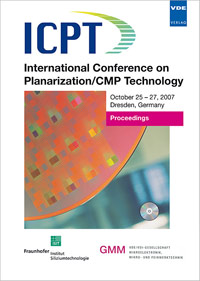Fabrication of Surface Acoustic Wave Structures with buried Copper IDTs using the Copper Damascene Process
Konferenz: ICPT 2007 - International Conference on Planarization / CMP Technology
25.10.2007 - 27.10.2007 in Dresden, Germany
Tagungsband: ICPT 2007
Seiten: 7Sprache: EnglischTyp: PDF
Persönliche VDE-Mitglieder erhalten auf diesen Artikel 10% Rabatt
Autoren:
Menzel, S.; Reitz, D. (Institute for Complex Materials at Leibniz-Institute for Solid State and Materials Research (IFW) Dresden, Helmholtzstr. 20, 01069 Dresden)
Künzelmann, U.; Albert, M.; Bartha, J.-W. (Semiconductor and Microsystems Technology Laboratory (IHM), Technische Universität Dresden, 01062 Dresden)
Inhalt:
Interdigital transducers (IDTs) for surface acoustic wave (SAW) structures are recently fabricated by aluminium or its alloys or Al-based multilayers based on interconnection line technologies using the lift-off process. The main restrictions are metal residuals as well as limitations in lateral resolution, their power durability, reliability and lifetime. Using copper or copper alloys as finger material the power durability can be significantly improved, and with buried finger electrodes most of other disadvantages can be overcome. The copper damascene technique which is commonly used in the back end of line (BEOL) has so far not been used for the fabrication of SAW structures. With the adoption of the damascene technique for the fabrication of SAW filters, sensors, or actuators, smaller and narrower finger structures can be implemented for a wide GHz range of operation. In this paper the application of chemical mechanical polishing (CMP) for the manufacturing of a SAW device on a LiNbO3 wafer is presented. Special CMP features due to the layout, dishing and erosion as well as CMP induced effects i.e. structure transformations at room temperature are illuminated and discussed. Finally, investigations on the durability and applicability of the fabricated devices are summarised.


